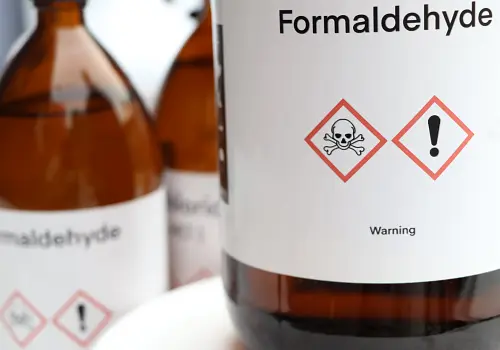
Formaldehyde is an invisible indoor air pollutant with a volatilization period that can last up to 20 years! For families moving into new homes, especially those with children, the elderly, or pregnant women, it is a major health concern. Let Renovation Expert briefly explain formaldehyde, its safe concentration standards, the pros and cons of detection methods, and the best time for detection.
New Home Hidden Killer: Formaldehyde and Its Hazards
Formaldehyde (HCHO) is a colorless, pungent-smelling volatile organic compound (VOC) that has been classified by the World Health Organization as a "Group 1 carcinogen." Its main sources are the "adhesives" widely used in decoration and furniture, such as new furniture, cabinets, and wooden floors made from artificial boards (like fiberboard and plywood), which are all sources of indoor formaldehyde release. Secondly, paint, especially latex paint, itself contains formaldehyde. However, many paint brands on the market now offer anti-formaldehyde formulas that can purify odors and decompose formaldehyde.
Even if low-formaldehyde building materials are chosen, when there are many of them, the concentration can accumulate and potentially exceed standards. Short-term exposure can cause coughing, watery eyes, and skin allergies; long-term inhalation can increase the risk of asthma and even cancer, posing particular harm to children whose respiratory systems are still developing.

Is the Formaldehyde Level in My Home Safe? Understanding Concentration Standards
Relying solely on smell to judge formaldehyde concentration is unreliable. To assess it objectively, you must refer to scientific measurement standards. Here are two main reference indicators:
- World Health Organization (WHO) Standard: Recommends that indoor formaldehyde concentration should be below 0.08 ppm (or 100 µg/m³). This is currently the widely adopted international health guideline value.
- Hong Kong Environmental Protection Department《Indoor Air Quality Management Guide for Offices and Public Places》: (30-minute average) Formaldehyde concentration is divided into two levels: below 81 ppbv (approximately 0.066 ppm) is "Good Level," and below 57 ppbv (approximately 0.046 ppm) achieves "Excellent Level."
How to Detect Formaldehyde? Advantages and Disadvantages of Three Main Methods
There are different methods for detecting formaldehyde on the market, with varying accuracy and costs. Before choosing, it's important to understand their pros and cons:
1. Formaldehyde Test Kits/Strips:
- Advantages: Low cost, simple to operate.
- Disadvantages: Low accuracy. Can only provide rough qualitative results, unable to give precise numerical values, and highly susceptible to environmental interference, with limited reference value.

2. Self-Purchased Portable Formaldehyde Detectors:
- Advantages: Reusable, instant readings.
- Disadvantages: Varying accuracy. Budget options cost only a few hundred dollars, but "semiconductor-type" devices are easily interfered with by other odors and have large errors; professional-grade "electrochemical-type" devices are accurate but expensive, ranging from several thousand to tens of thousands of dollars, making them unsuitable for general households.

3. Hiring a Professional Company for On-site Testing:
- Advantages: The most accurate and reliable method. Professionals use precision instruments under standard conditions to provide precise reports on formaldehyde and other VOC levels.
- Disadvantages: The cost is relatively high.
For families who genuinely care about their health and seek accurate results, hiring a professional company for testing is undoubtedly the safest choice.

Prevention is Better than Cure: The Best Time for Formaldehyde Detection
Conducting formaldehyde detection at the following key time points can maximize its effectiveness:
- After new home decoration or full renovation: This is the peak period for formaldehyde release; it's most ideal to perform detection after all work and furniture are in place, but before officially moving in.
- After adding a large amount of new furniture: To assess the risks brought by the "accumulation effect."
- When there are pregnant women, infants, young children, the elderly, or long-term patients at home: To provide a safe living environment for highly sensitive groups.
- After moving in and experiencing unexplained physical discomfort: If family members commonly experience symptoms such as headaches or persistent coughing, which improve after leaving the unit, detection should be arranged immediately.
Solving from the Root: Professional Cleaning and Formaldehyde Removal Services
While continuous ventilation is a basic method to reduce formaldehyde concentration, it is time-consuming and limited in effectiveness. To truly move in with peace of mind, a thorough "pre-move-in deep cleaning" and targeted "formaldehyde removal" service are crucial.
The residual fine dust, paint, and adhesive stains left after renovation not only affect appearance but also pose a threat to respiratory health. As a one-stop home support platform, the professional team at Home Clinic provides comprehensive post-renovation cleaning services, thoroughly removing all pollutants left from the renovation. More importantly, customers can opt for professional formaldehyde testing and removal services as needed. With one appointment, your new home can be truly clean and safe from the inside out.
【Get a Cleaning Service Quote Now】
From renovation quotes to pre- and post-move-in, comprehensive one-stop support!
>> Get Free Renovation Quote: https://hkdecoman.com/measure
>> Book a Home Clinic (Inspection/Cleaning/Repair): https://clinic.deco-x.com/
Specialized Sections for Various Property Types:
>> Public Housing https://decoman-publichousing.com/
>> Private Housing https://decoman-privatehousing.com/
>> New Developments https://decoman-newproperties.com/
>> Tangyang Building https://decoman-tenement.com/
================================================================
*** This article is republished with permission from Renovation Man ***